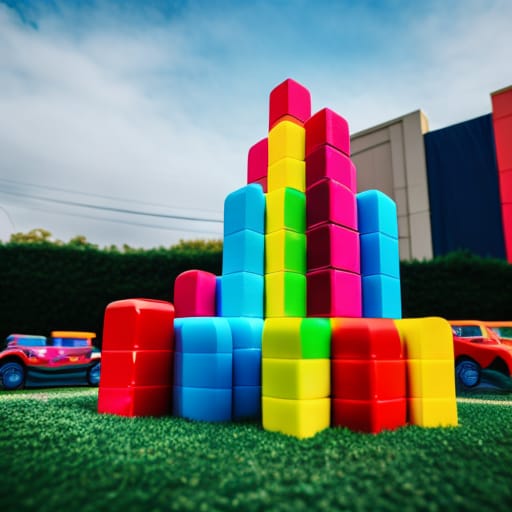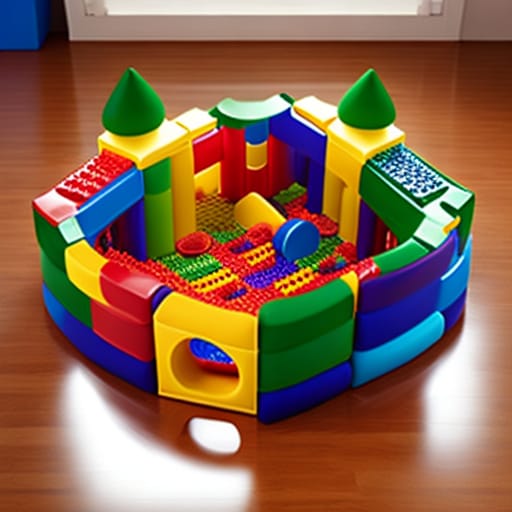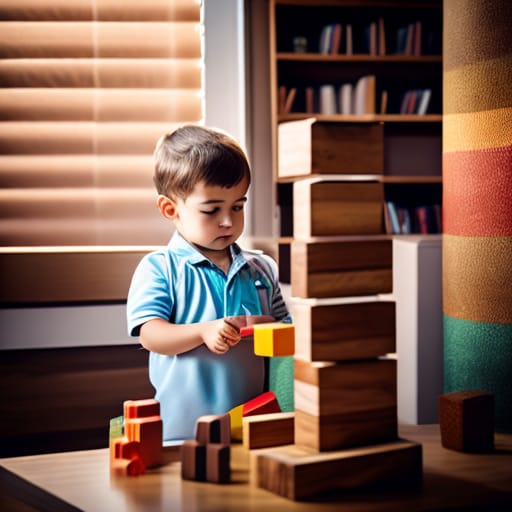Giant soft building blocks are a versatile open-ended toy that supports young children’s development in crucial ways during their formative early years. These oversized, lightweight foam blocks come in a variety of vibrant colors, shapes and textures to inspire creativity and imagination. This comprehensive guide covers everything parents and educators need to know about incorporating giant blocks into playtime and early education settings.

An Introduction to Giant Soft Blocks
Giant soft building blocks are extra-large foam blocks, ranging from around 5 inches to over 12 inches in size per block. They are specifically designed for small hands to grasp, lift and manipulate to build imaginative structures. The blocks feature precise 90-degree edges that allow for ease of stacking and aligning.
The blocks are constructed out of durable lightweight foam or cloth materials that make them easy for young toddlers to handle. The foam material also provides a soft, safe texture with a little squish, reducing injury or damage if structures topple over. Most sets include around 30-40 colorful blocks in shapes like rectangles, arches, triangles, columns and bricks.
These chunky blocks are suitable for children as young as 12 months up to around age 6. They can be used for independent play or more structured building activities in educational environments like preschool classrooms.
Key Benefits of Giant Block Play
Giant soft building blocks might look like just another simple toy, but they provide immense value beyond basic entertainment. Here are some of the key benefits giant block play offers:
Develops Motor Skills
The chunky shape and size of the blocks helps to develop hand strength, dexterity and coordination. Lifting, carrying and placing the lightweight blocks utilizes gross motor skills, while precise stacking promotes fine motor control. Enclosed handles on some blocks further assist little hands.
Fosters Spatial Skills
Assembling structures requires visualizing shapes in space and understanding concepts like balance, symmetry and geometry. Giant blocks allow kids to explore these mathematical and scientific concepts hands-on by building vertically and horizontally.
Promotes Problem Solving
There are endless possibilities for what kids can construct with giant blocks, requiring them to continually create new solutions. Block building organically develops crucial thinking, logic and critical analysis abilities.
Boosts Creativity
The open-ended nature of giant blocks as a toy means there is no right or wrong way to use them. Kids are free to build as they imagine, constructing their own worlds. This fosters creativity, self-confidence and emotional growth.
Enables Collaborative Play
Large block structures often require teamwork to assemble, guiding children to cooperate, communicate roles and share ideas. Social interaction is woven naturally into block activities, supporting emotional intelligence and relationships.
In addition to being just plain fun, giant block play lays the foundation across all domains of early development. The versatile blocks can also teach academic concepts, be incorporated into therapy, and adapt to a wide age range.
Selection of Giant Building Blocks
If you’re sold on the developmental benefits of giant block play, the next step is to select a set of blocks. With many materials, features and types of block sets now available, here is what you need to know about choosing the right giant soft blocks:
Block Material
The most common block materials are:
- Foam – Lightweight, soft texture, more delicate, lower cost
- Wood – Harder, durable, eco-friendly, higher cost
- Cardboard – Recyclable, less durable, cheaper
Foam is best for younger toddlers as it’s safe if collapsed structures fall. But wood or cardboard work for kids 3+ and hold up better long-term.
Size
Standard dimensions range from 5 inch up to over 12 inches per block. Bigger sizes are easier for younger kids to grasp and are better for collaborative building. Smaller blocks allow for more intricate structures.
Weight
Look for specifications on the weight capacity tested for the blocks, as an indicator of their durability and stability. Heavier blocks in natural wood or stone materials provide more stability when stacking above shoulder height.
Types of Blocks
Seek out sets that offer an array of shapes like bricks, arches, triangles, cylinders and ramps. Variety in angles and geometry expands the building possibilities. Curved blocks also help teach spatial skills.
Number of Blocks
Around 30-40 blocks offers enough variety for open-ended structures without being overwhelming. Bulk discounts are sometimes available on larger 100+ block sets for classrooms.
You can also explore options like interlocking blocks, engraved blocks or blocks with bright patterns and textures to engage visual sensory processing. Special needs therapists may recommend certain qualities as well.

Introducing Giant Blocks into Education
Giant soft blocks have broad applications stretching from preschool classrooms to therapy offices and the child’s playroom at home. Their versatility makes them an ideal educational material or toy for supporting development.
Classroom Integration
In preschool and early elementary, giant blocks invite imagination during free play periods. For more structure, teachers can also incorporate blocks into areas like:
- Math – Patterning, shapes, counting, measurement
- Science – Balance, gravity, hard & soft concepts, classification
- Literacy – Storytelling inspiration, labeling structures
- Art – Design, symmetry, collages with blocks & craft materials
Small groups of students can work together to construct block structures to demonstrate concepts. Blocks also neatly divide classroom areas for different learning zones when stacked on shelves.
Therapeutic Settings
Occupational therapists frequently use giant building blocks to address developmental delays, sensory integration challenges and physical rehabilitation needs:
- Improve gross motor skills through lifting/carrying
- Refine fine motor control by precision stacking
- Build coordination and balance abilities
- Develop spatial awareness and geometry skills
- Provide proprioceptive sensory input
The engaging, play-based nature of blocks therapy helps children progress key skills.
At-Home Learning
Free play with giant blocks enhances cognitive, physical and social capacities – exactly what rapidly developing young minds need. Simple block play cultivates the foundations for more complex academic concepts children tackle later on.
Giant blocks are an ideal open-ended toy for toddlers and preschoolers to grow with at home. Kids can use them independently or build collaboratively with siblings and parents. Minimal facilitation is needed, allowing caregivers time to watch development unfold through creative block structures.
DIY Giant Block Inspiration
Purchasing a complete set of giant blocks offers convenience, but you can also create your own oversized building blocks with some simple DIY tips. Custom blocks let you tailor sizes, color schemes and decorations.
Materials
- Foam sheets, foam puzzle piece floor tiles or yoga blocks
- Duct tape, packing tape or fabric glue
- Acrylic paint, permanent markers, stickers, fabric
- Box cutter or electric knife to cut foam
Step-By-Step
- Cut foam tiles into brick and square sizes
- Layer foam pieces into block shape and secure edges with tape or glue
- Decorate block sides with paint, markers, fabric or other materials
- Use stickers, wood slices or tiles to create texture blocks
DIY blocks make great gifts too – help young ones decorate their own structures!

Accessibility Features for Special Needs
Giant blocks present a versatile material adaptable to nearly any ability level or learning style. Certain qualities and features cater better to special needs populations across the autism spectrum, with sensory integration differences or facing physical challenges:
- Extra lightweight blocks reduce fatigue for motor delays
- Noise-dampening materials for sound sensitivity
- Textured sides or tactile symbols provide sensory input
- Bright colors and patterns suit visual learners
- Stability features (interlocking blocks, heavy weighted blocks) for children who need structure
- Portable storage bags for easy transport and clean-up
Therapists also praise giant blocks for their ability to be:
- Child-directed or therapist-directed as needed
- Expanded into pretend play to address social/communication goals
- Simple enough for non-verbal students
- Calming and focused or energetic and silly
Like snowflakes, no two children learn exactly the same. But giant blocks build development across most cognitive, physical and social domains. Check in with your child’s specialists for guidance on selecting specialty block features to suit specific learning profiles. Custom DIY blocks also allow for great personalization and grading up/down with texture, weight and stability adaptations.
Final Takeaways
Giant soft building blocks offer seemingly endless benefits: enhancing cognitive growth, improving fine motor abilities, encouraging creativity and nurturing social capacities. As both an open-ended toy and a manipulative for teaching structured lessons, oversized blocks fill an important niche in early childhood education.
Their lightweight, safe foam construction makes giant blocks well-suited for toddlers first venturing into construction toys around 12 months up through primary school. As children grow, blocks continue providing the just-right challenge to expand spatial reasoning, problem solving and motor coordination all while absorbing children in joyful, engaged play.
For parents, giant blocks promise minimal supervision with maximum developmental impact. Teachers find blocks inherently multidisciplinary, adapting across learning domains to build literacy, math, science and art concepts. Therapists utilize blocks to address developmental delays and sensory needs in a motivating mode therapy medium.
With few toys eliciting as many sheer smiles and spontaneous giggles of pride in builders of all skill levels, giant soft blocks deliver lasting value for years of constructive play. Allow your budding builder to tap into the huge potential of giant blocks today!
Frequently Asked Questions
What age are giant blocks suitable for?
Giant soft building blocks are suitable for children as young as 12 months old up to around age 6. Their lightweight foam construction and oversized dimensions make them easy for tiny hands to maneuver and lift. Blocks build fine and gross motor skills crucial for toddlers. Around 3 years old, kids have developed the dexterity and balance to construct taller structures, still enjoying the challenge of giant blocks until early elementary school age.
How many giant blocks should I get?
We recommend 30-40 chunky blocks for a good starter set. This number provides variety to spark creativity in open-ended structures without being so high that clean-up becomes tedious. Many classroom packs feature 100+ blocks for more students to build simultaneously. Consider your storage space as well. A set of 40 blocks in a few geometric shapes and colors still allows for endless designs.
What concepts can giant blocks teach?
Open-ended construction play builds physical abilities like hand strength, coordination and balance. Arranging different shapes and sizes introduces early geometry, symmetry and fractions concepts. Stacking blocks skyward, seeing what pieces fit together and balancing irregular shapes promotes spatial reasoning, problem solving and critical thinking. Collaborating on giant structures nurtures social-emotional growth. Beyond academics, the sensory feel of squishy foam against little fingers provides neurological stimulation.
Are giant blocks safe?
High-quality foam blocks made specifically for young children will meet safety standards, with no detached small parts or toxic materials to avoid choke hazards. Pick blocks marked ASSTM toy safety approved. Foam construction means soft, lightweight blocks that don’t hurt if a tower topples. Precisely cut edges also prevent scratches. Building and playing with blocks teaches children cause-and-effect thinking to avoid risky stacking. Always supervise play.
Can you make DIY giant blocks?
Absolutely! While you can buy beautiful wooden or printed giant blocks from specialty retailers, custom DIY giant soft blocks allow you to control sizing, colors and decorations. Upcycle foam packing materials or foam play mat tiles. Secure stacked foam pieces with duct tape or fabric glue, then decorate away with paint, markers and stickers or fabric. DIY blocks also make wonderful gifts for little crafters to create their own building designs. Let your child’s imagination soar!